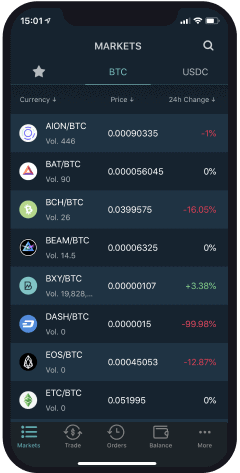POLY falls into the category of security tokens, that is why not all exchanges include it in their trades. After all, those types of tokens carry with them a lot of legal implications. That is because the income they provide potentially can bring tax implications. Not only that, but they can also provide equity and voting rights. All those implications create an extra layer of complexity that not every exchange is willing to take.
Even though it is not supported by all exchanges, you can sell your POLY for any significant cryptocurrency on an altcoin exchange. That, of course, includes BTC. The process is similar to any other cryptocurrency trading.
You just need an account on the exchange you selected and then fund it via Polymath Network. Then you can sell your POLY for BTC or even Ethereum. After that, you can easily transfer your new tokens to your wallet. People usually exchange POLY for either BTC or ETH because they are the most liquid options; at the same time, those two are very easy to cash out.
In case you want to check current exchange rates, it is effortless to find a calculator that can provide you with that information. Most major wallets, investor pages, and sites dedicated to cryptocurrency have such calculators. You can also input the quantity of Polymath tokens you are interested in selling and select the cryptocurrency you want in exchange. Those platforms generally use rates of hundreds of thousands of exchange pages to provide you with a number that closely resembles what you can get in most exchanges.
Convert POLY to other currencies
As mentioned above, you have the option to exchange your POLY tokens for any major cryptocurrency like BTC, ETH, or even XRP. The steps to take in order to do so remain the same. First, you create an account in an altcoin exchange of your choice and then fund it with Polymath Network. From there, you can exchange it for any token that exchange offers.
Once you have exchanged your POLY tokens for any major cryptocurrencies, it is much easier to cash out, especially if you have Bitcoin or Ethereum that are highly liquid. You can sell them for fiat currency at any moment.
About The Polymath Platform and its token – POLY
The native token of the Polymath platform is called POLY. The main goal this platform has is to improve and simplify the process of creating security tokens as well as selling them. Security tokens present a lot of complications when it comes to trading or exchanging them. That is mainly because those types of coins are subject to stringent government regulations, something rare among cryptocurrencies. That comes as a result of these kinds of tokens providing claims to dividends or equity for the company that created them, which is what happens in most cases.
With the standard that Polymath wants to introduce, the whole process would be simplified. That is because, in this standard, all government regulatory requirements are embedded into smart contracts, and of course, are fully compliant with them. They believe that the next step in the evolution of such transactions is to replace term shareholders with token holders, all being done within the Blockchain.
When it comes to public offerings, companies are forced to spend a lot of resources and time in the process of registering their securities with the pertinent government bodies. Moreover, that process seems to get more complicated with time. Polymath is set in helping people legally register their new tokens. At the same time, they want to provide an option for exchange that is decentralized and has lower fees.
This token, POLY, is limited to one billion units. Up until the tenth of January 2018, early adopters had the chance to register for airdrop. Those who signed up for that program received two-hundred and forty million POLY tokens. The remaining seven hundred and sixty million POLY tokens remained within the team to be used on a later date.
In regards to security, there are three layers on this platform. Those layers are, in order, the application, legal, and protocol one. That system is an excellent way to assure the compliance of your token, and more importantly that it will remain compliant.
The main goal this three-layered system tries to accomplish is to reduce the legal complexity as well as the ambiguity that surrounds these securities. Of course, lowering fees and improving the liquidity of your assets is another goal of this platform. It is important to remember that security tokens are traded differently than traditional tokens. While you can easily trade most tokens on any exchange platform, security ones have various legal implications, which makes the process much more nuanced.
It is crucial to have exact information about who holds a security token at any and all times. That is essential because those kinds of tokens have the potential to provide income that carries tax implications or, in some cases, voting rights on a certain company. This is where Polymath comes in because only pre authorized investors can hold security tokens that were created on this platform. The POLY token was designed to be used for payments throughout the platform.
The people on the Polymath platform can receive POLY as payment. That includes issuers that are posting bounties so developers and legal delegates can bid on providing certain services. Of course, the developers can get tokens for their work; the more complex the job, the more POLY they get. KYC providers, legal delegates, and investors are also able to post bounties, interchange services for POLY as well as exchange POLY for whatever it is they need. Logically, when talking about providing specific services, especially from the legal delegates and developers, the amount of POLY issuers pay varies depending on how complicated the security of the token to be created is.
One important detail about any platform, especially when talking about cryptocurrencies, is the team behind the project. Having a team from well-known authorities in the industry gives confidence to investors and anyone looking into the platform. That is precisely the case here, Trevor Koverko, which is considered a veteran in both cryptocurrency and Silicon Valley, is the one leading this project. He got into Bitcoin when it was only twenty bucks, and Ethereum at a time when you could get two thousand ETH for one BTC. So you could say he has a great vision for where things are going.






